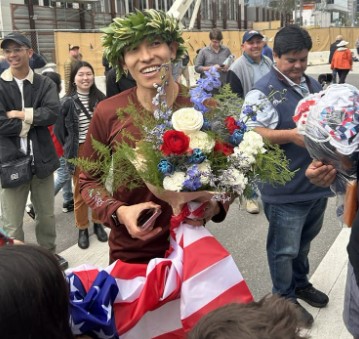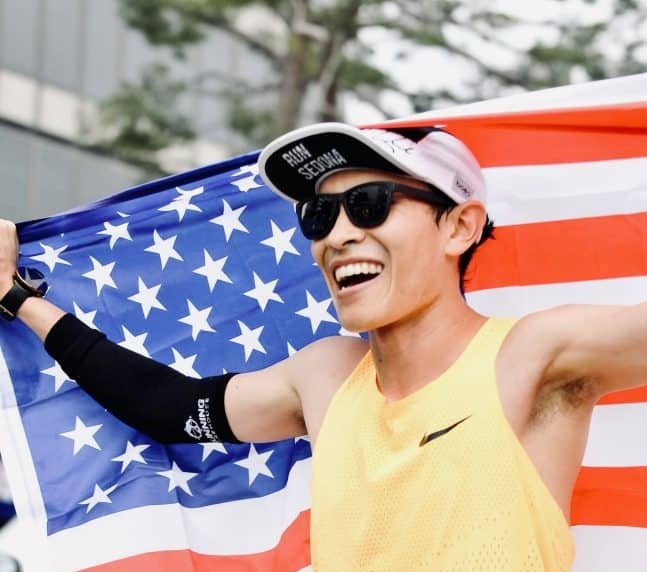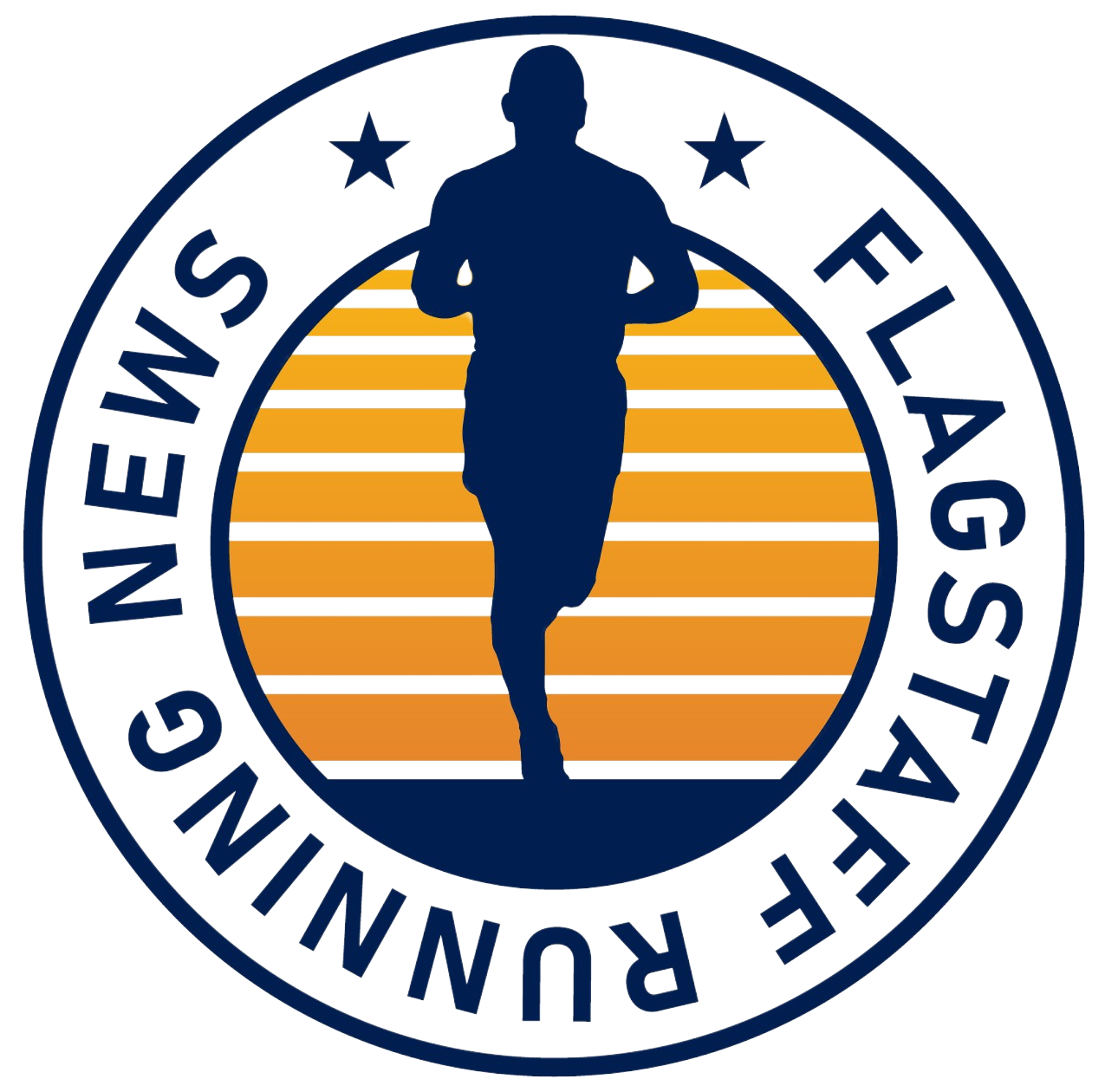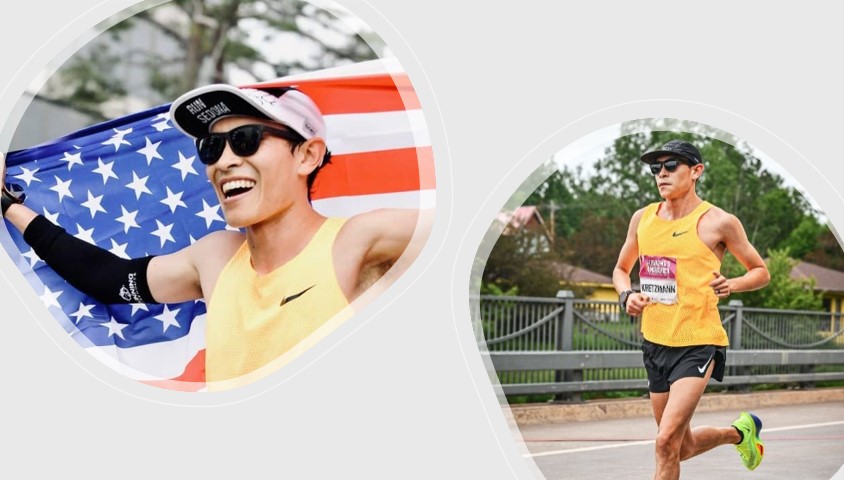They handed him the microphone at the starting line Saturday morning. Say a few words, the Hopi Footprints 10K race director told Hosava Kretzmann. So soft-spoken that even the mic didn’t help amplify him much, Kretzmann nonetheless delivered a powerful message: that the runners should think of the “why,” the reason they run when things get tough, be it running for family, for clan, for health, for the rain.
Then, the runners took off, and so did Kretzmann, 29, easily winning the trail race at Fort Tuthill County Park.
For an elite marathoner such as Kretzmann, coming off a personal best of 2:18:59 at last month’s competitive Grandma’s Marathon in Minnesota, the Hopi community race may have seemed like a glorified training run. But because the 10K benefited his people – Kretzmann has both Hopi and Dine roots – there was added significance.
Every time Kretzmann laces up his shoes, every time he takes that smooth stride to the streets or the trails in Flagstaff or far-flung locales, he asks himself his “why.”
The answer, always, is both simple and profound: for his tribes.
Though an enrolled member of the Navajo (Dine) Nation, Kretzmann was raised Hopi and remains greatly influenced by his native culture, even after moving off the reservation on the Third Mesa and settling in Flagstaff and Prescott, even after running at Fort Lewis College, even after starting a doctorate program in public health and working full-time at NAU.
Kretzmann remains dedicated to his people and their well-being. Part of his job at NAU is to evaluate how programs can better benefit indigenous and first-generation college students. And, in his abiding passion of running, he also sees his efforts as something greater than mere self-satisfaction and the pride of winning a race.
He sees himself as part of a continuum, the latest (but certainly not the last) of a long line of heralded Hopi runners dating back centuries, clear back to the 1,600s when Hopi runners helped plan and launch incursions against Spanish invaders to the homeland.
A day before the Hopi Footprints race, Kretzmann showed up for an interview wearing a Louis Tewanima, a 1912 Olympic silver medalist from the mesas of Eastern Arizona. Kretzmann idolizes Tewanima and honors scores of Hopi ancestors who ran because it was an integral part of community life.
Kretzmann said he feels honored to carry on that tradition and, as he looked out at the smattering of teen Hopi runners at the starting line of Saturday’s race, perhaps felt a connection and compulsion to keep the tradition going strong. He is steeped in Hopi running lore, referencing often the seminal work on the subject, Matt Sakiestewa Gilbert’s 2017 book, “Hopi Runners: Crossing the Terrain Between Indian and American.”
Just as fervently, though Kretzmann wants to be the best runner he can be. He was the top American in the 2023 Los Angeles Marathon, his debut, and came up just short of qualifying for the U.S. Olympic Marathon Trials in February. But the future looks promising after his 2:18:59 performance at Grandma’s, his eyes set on 2028 and the new Olympic Trials.

Driven, he is. Certainly. And the attention he received after he burst onto the scene after the L.A. marathon was appreciated. But Kretzmann never strays far from what really matters, running for his people and the rain.
Modest almost to a fault, Kretzmann is at his most animated and engaging when talking about the rich cultural heritage of Hopi running, which he learned from his mother, born Dine but adopted and raised Hopi.
“My mom would always tell me stories of amazing runners,” he said. “She got to witness them do amazing things. Some made it close to the Olympics, but it really comes from a lot of our ceremonies; it’s incorporated in our ceremonies — coming of age, the Kachina dances. Kachinas are spiritual deities and they resonated here from Nuvatukwi’ovi, the SF Peaks.
“Hopi runners, you’re self-sacrificing, giving a lot for others. … Running has always been associated with bringing rain to our community. The Hopi people were originally farmers, caretakers of the land, growing corn. In our creation story, we are told that when we ascended into this world we were given the short ear of corn, which was representative of having a short life but a meaningful life. We’ve have a hard life, in our communities, and running, too, is really tough physically, mentally and spiritually.”
Kretzmann recalled a particular early 1900s photo included in the “Hopi Runners” book that particularly resonated with him.
“They were all lined up right behind a line drawn in the sand,” he explained. “You can just see these runners are just naturally fit and look like runners. A lot of times these races would be held among the villages to see who’s the fastest. It hasn’t changed. It’s still that way now.
“In our ceremonies, there’s actually a Kachina, usually one of the teenagers within the Hopi community – you never know who because their faces are covered, have masks on – so around the time of the home dance, symbolic of the kachinas going back to the San Francisco Peaks, they’ll point at you and draw a line in the sand to try and race you, the kachinas will. If you don’t race them, they’ll chase you, chase you with charcoal on their hands. And they’ll smear it all over your face if they catch you. By the end of the dance or race, you might see a lot of young men with charcoal on their faces.”
Talk about motivation to run. Kretzmann laughed and explained the practice finely woven into the fabric of Hopi society.
“It’s pretty neat,” he added, “that I grew up with these stories that help me learn more about myself and my community, especially through the time of the Pueblo Revolt (1680, against Spanish colonizers). We can be proud of that. Out there (on the reservation) it can still be a tough place to live.”
An inner toughness, a willingness to accept and transcend hardship, has helped Kretzmann in his running career as well.
He is trying to be an elite runner while holding down a full-time job (50 hours a week) as an evaluation associate for the NAU Vice President of research while at the same time working on his Ph.D in NAU’s interdisciplinary health program. And, on top of that, he runs 90 to 100 miles per week and even works while he’s on the road at races.
And there’s this obstacle, too: He is unsponsored and hasn’t signed with a professional team.
Yes, Kretzmann does have partial sponsorship from Run Flagstaff, the specialty running store, and its offshoot Team Run Flagstaff. That helps with shoes. And Hammer Nutrition is a sponsor for his fueling needs.
But Kretzmann does not draw a salary from a pro team or major shoe company, such as Hoka NAZ Elite or Under Armour Dark Sky Distance. He doesn’t even have an agent. He is, essentially, on his own, and trains alone when his buddies, Brandon Joe and Joshua Ramirez, can’t join him. That means lonely 5 a.m. runs in the dark, biting winter and evening runs after a long shift at work or studying.
It can be a grind, he admits. But his seemingly innate positivity pulls him through.
Does his busy life make him mentally tougher, in some way?
“I think so,” he said. “There’s no easy way around it. You gotta do the work if you want to see race times come down. It’s good mental fortitude to think. I gotta deal with it even if it’s freezing cold outside. My wife (Sheera) has always been there. She’s my biggest advocate. She’s told me to get out the door when I’m tired. Without her, my mileage would’ve tanked. I told her my dream a long time ago when we first met, and she’s always supported me.”
That dream – to be an elite marathoner who qualifies for the Olympic Trials – may have seemed far-fetched to some. Kretzmann said he wasn’t even the fastest runner on his Prescott High School team. He was, however, good enough to get a scholarship at Division 2 Fort Lewis College in Durango, Colorado, but he wasn’t a national champion on that level.
Little matter, though. Kretzmann kept at it, the dream percolating inside all along. By 2020, two years out of Fort Lewis College, he logged a 4:15.69 indoor mile at a meet at NAU’s Skydome, the time converting to an altitude adjusted 4:05. Around that same time, he ran a 1:05 half marathon in Phoenix and started mulling his chances for a marathon trials qualifier either via the half (1:03) or full (2:18).
But the vagaries of life interceded and Kretzmann was dealt, literally, a blow. He was T-boned by another car while driving back from a workout, and missed nearly a year of training recovering from left-leg nerve damage sustained in the crash.
Once he finally healed and returned, Kretzmann recalls he ran a cross-country race at Buffalo Park and finished eighth in a tough field. Sheera was at the race, and Kretzmann recalls her reaction.
“It was when we were first dating, and she said to me, ‘You ran that really well. You’re still fit,’” Kretzmann said. “She was like, ‘You gotta keep training. You’ve got to take this racing more seriously.’”

The result was a slow build to his breakthrough race at the L.A. Marathon in March, 2023. Actually, two months before, Kretzmann ran 1:04.26 at the Houston Half Marathon, a harbinger of things to come.
Choosing to make his marathon debut in Los Angeles was a curious choice by Kretzmann and his coach (originally Dylan Belles; now Craig Hunt, the Coconino College coach), because it’s a hilly course and tends to get warm. But he was sixth overall and the first American in 2:19:55, telling reporters afterward: “I doubted because before any race I thought to myself, ‘What am I doing here? I shouldn’t be here.’ Then the gun goes off at the start and that negative thought quickly dissolves and I realize, I’m right where I should be, representing my tribes.”
His L.A. result raised Kretzmann’s profile substantially. Phoenix TV stations did interviews. So did National Public Radio. The often-insular elite running community paid attention, too, wondering where he came from.
“We gain a lot of perseverance because of the hardships we face. That’s what I tell (NAU) students, whether they are native or non-native. Times are going to get tough, but you can push through it. Just keep the end goal in mind, whether it’s becoming a doctor or going to law school or art dance and music. You gotta put the work into it if you want the outcome.”
Hosava Kretzmann
But no solid offers of team or shoe company sponsorship was forthcoming.
“No one has reached out to me,” he said. “I get a lot of messages on Instagram and had news reporters say like, ‘Oh, I know this guy, I’ll get you in contact with him, they work for Hoka and be willing to sponsor you.’ I’ve heard that enough times that I don’t really get my hopes up anymore. People tell me this and I’m super stoked for it, but the reality is they might never reach out again. That’s happened enough times now, so, you know…”
The buzz remained, though. And Kretzmann kept pushing. But then came a few setbacks. He ran 2:29:27 at the McKirdy Micro in New York, a small marathon specifically designed for emerging elites to go for the Trials standard. Well short of the 2:18 standard, but Kretzmann learned from his sophomore effort.
In the days leading up to it, the media seemingly latched on to Kretzmann’s story.
“Channel 3 in Phoenix did a big feature story on me, and Nike put up a billboard of me in New York City,” he said. “I had a lot of pressure, a pressure I’m not used to. I wasn’t used to interviews and to have a billboard in New York of me? Man. I’m so thankful for those opportunities, but it was pressure.”
His third marathon came just two months later, a last chance for the Trials at the California International Marathon in Sacramento. He ran 2:35, after missing a few water bottles and breaking down around the 16-mile mark.
Kretzmann may have been disappointed, but he was undaunted.
It’s in his nature to persevere, even in the face of critics telling him his goals are unachievable. When he was a kid, his family couldn’t always afford running shoes, so Hosava took his older brother’s worn out pair, wore several layers of socks to make the shoes fit and went out an run.
“That’s just what you have to do,” he said. “I was not the best runner in high school. I don’t think anyone saw anything special in me. I can’t recall a time where anyone said to me, ‘What you did was amazing, so cool.’ My friends were there for me, but no one else. That’s one reason why I haven’t really shared too much about my goals. In the past, I’d tell people and they’d say, ‘You can’t do that.’ It was kind of upsetting. You want to see your goals through and tell people but a good amount of them didn’t believe in me and shot me down.”
No matter what, Kretzmann kept running.
It’s the Hopi way.
“We gain a lot of perseverance because of the hardships we face,” he said. “That’s what I tell (NAU) students, whether they are native or non-native. Times are going to get tough, but you can push through it. Just keep the end goal in mind, whether it’s becoming a doctor or going to law school or art dance and music. You gotta put the work into it if you want the outcome. Even if you don’t get the outcome, at least you can be proud of all the hard work you’ve put in to get to that point.”
Things started looking up this year. Kretzmann got a good training block and build-up in, even though he had to squeeze in 100-mile weeks between working 50 hours a week.
“Even during that time of marathon training (over the winter and into the spring), I was still working a lot,” he said. “And it’s not as if I take a lot of days off from work to do these races, either. I’ll plan it out so, even when I travel, I’m still working, because I can’t afford to take those days off. I need the money.
“That was difficult to still keep focus on my job while trying to qualify for the trials. I’d do more, honestly, if I wasn’t working as much. My boss is very flexible and understands this is a big passion of mine. I think after last year’s L.A. Marathon, that brought attention to NAU. I try to hype up NAU as much as I can because it is a great place.”
The pressure was not so great on Kretzmann in Duluth on June 22. He finished 17th, running nearly a minute faster than in L.A. a year ago.
“It was a great race,” he said. “The people there were amazing. Conditions were great to run fast. I was going in with one goal – to break 2:18. That’s still a goal of mine from the trials; I still wanted to go for it. I know I can do it, so I wanted to try it again. Because that gets you into a lot of good races. That helps for the next year and two years down the line. I was happy to be there, be accepted into the elite race. You never know if you’re going to be accepted or not.”
Up next for Kretzmann, he hopes, will be elite entry into October’s Dublin Marathon, which would be his first out of the United States. He’s still chasing the sub-2:18 and believes he is more than capable. Naysayers don’t get to him.
“I think I’ve dealt with it for so long that I’ve just put the blinders on and focused ahead,” Kretzmann said. “Focus on the few people in your circle who believe in you. Focus on what they say.”
And run for his “why.”


Leave a Reply